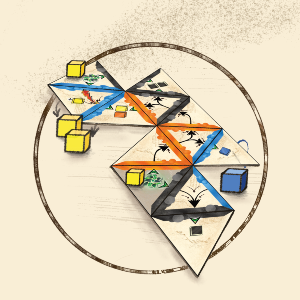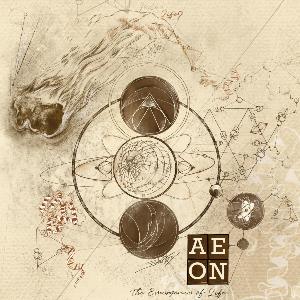Discovering the origins of life
25 Nov 2021
On the moment when something entirely new emerged from inanimate matter: The CRC “Emergence of Life” and the Deutsches Museum developed the game AEON.
25 Nov 2021
On the moment when something entirely new emerged from inanimate matter: The CRC “Emergence of Life” and the Deutsches Museum developed the game AEON.

The young Earth was still under heavy fire from space. | © Priyanka Oberoi
It’s almost four billion years before the present day. The young Earth is not yet a very comfortable place, but it has cooled down. The comet and meteorite bombardment has left its mark, the collision with Mars-sized planet Theia created the Moon and the conditions for Earth’s magnetic field. Thick clouds now hang in the orange sky and the ocean resembles a greenish soup. There isn’t much land yet, just a few bare black rocks jutting out of the muddy water. But deep down in the ocean — or perhaps somewhere else entirely — something is happening: the first life is emerging from simple biomolecules such as fatty acids and amino acids that come together to form membranes and RNA sequences. At some point, the smallest of all living things must have emerged: a first cell, enveloped and bounded by a membrane.
But how exactly did this first protocell come about? How did the miraculous transformation of dead matter into something living take place? Researchers from multiple disciplines are working on this very question and are still faced with a great mystery. Joining forces could help, and that is exactly what’s happening in the Collaborative Research Centre “Emergence of Life” (CRC 235).

The strategy game AEON is all about hypotheses on how life began. | © Priyanka Oberoi
“Emergence of Life brings together researchers from all disciplines and promotes scientific exchange,” says LMU Professor Dieter Braun, spokesperson and coordinator of the CRC. The idea is to synthesize approaches from astronomy, biology, chemistry, geology and physics.
The researchers are also keen to share the fascination of science surrounding the first steps towards life on Earth. To this end, some of the many hypotheses can now be explored with the strategy game AEON, a game developed by a group from CRC 235 together with the Deutsches Museum. The winner is the first to establish the basic mechanisms of life in a world of chemical molecules. And there are many possible ways to get there. “Within the CRC, research is being conducted on very different hypotheses, and that is also reflected in the game,” says LMU alumnus Dr. Karl Wienand, the CRC communication postdoc who came up with the idea for AEON.

Hydrothermal vents on the ocean floor are just one of the places where life may have originated. | © Priyanka Oberoi
“There are three mechanisms that scientists consider crucial for the emergence of life: an enveloping membrane, metabolism and replication,” explains Bernhard Altaner, one of the developers of AEON. Metabolism is the basic process by which energy is obtained and more complex molecules are built. Replication is the process by which biomolecules copy each other.
In the research around the beginnings of life, there are different ideas on how exactly these three processes first occurred and which one started it all. It could have begun with reaction networks of chemical molecules catalyzed by metals, in which simple compounds evolved into increasingly complex structures. Or it could have been lipids that spontaneously formed spheres and thus represented the precursor of the first cell. Or was it a world of self-replicating RNA sequences that started the whole thing off?
Hypotheses on the how are as diverse as on the where. Possible candidates include hydrothermal vents in the deep sea and hot springs or pools in volcanically active zones on land. The combination of energy-giving heat and a high concentration of chemical compounds may have favored the emergence of life in such places. Small pores in ice containing liquid water are also thought to have been one of the possible birthplaces of life. In this cold environment, the physical and chemical conditions would have been different than in volcanic heat, which would have had an influence on the first steps towards life. Equally, scientists can only speculate on whether biomolecules from outer space also contributed to the emergence of life.
“We don’t really have a good answer to the question of the origin of life,” says Karl Wienand. As a research assistant at the Deutsches Museum, he is now working on how to present the research behind AEON in an exhibition. This includes highlighting the fact that much is still in the realm of speculation: Any of the hypotheses could be true — or none of them. Perhaps life even arose several times in parallel, in different ways in different places.
So, will we ever know what it was really like? Probably not, because there are no fossils from that time. Researchers can only try to recreate the conditions of early Earth in the laboratory. “You can already recreate certain aspects of chemical evolution in the lab today, but whether you can really replicate the origin of life in a test tube is questionable,” says Bernhard Altaner. But, as Karl Wienand adds, “Even if you could, that would only be one possible path, and without a time machine we will never know whether the same thing happened four billion years ago.”

© Priyanka Oberoi
The idea was born in the spring during the virtual meetings of the interdisciplinary and cross-university Collaborative Research Centre “Emergence of Life” — and a group of nine PhD students and post-docs from LMU, TUM and Helmholtz Zentrum München set about implementing it. In cooperation with the Deutsches Museum, they developed a board game that conveys scientific knowledge about the origins of life on Earth in a fun way. The winner is the first player to produce primitive life. The game is already available to print out at home. Thanks to crowd funding, the developers have now had AEON professionally produced as well, so the game will be available to buy from the museum shop of the Deutsches Museum before the end of the year. Next summer, the Deutsches Museum will host the “Simpel. Komplex. Lebendig.” (Simple. Complex. Living) exhibition focusing on the origins of life, and the game will be used as an educational tool for school classes.